The global wireless fire detection systems market is valued at USD 1.62 billion in 2025 and is expected to reach USD 3.1 billion by 2035, reflecting a CAGR of 7.6%.
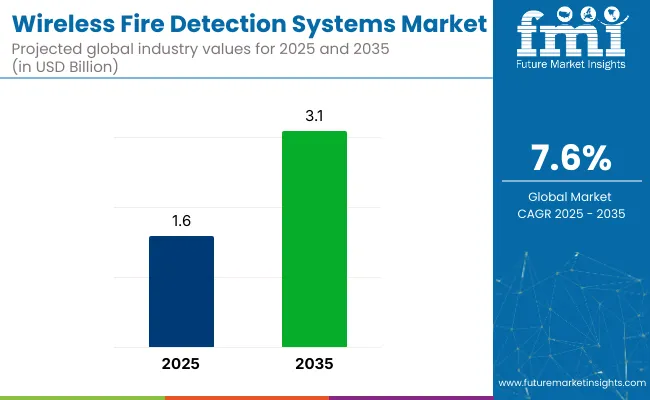
| Metric | Value |
|---|---|
| Estimated Size (2025) | USD 1.6 billion |
| Projected Value (2035) | USD 3.1 billion |
| CAGR (2025 to 2035) | 7.6% |
Growth is being driven by stricter fire safety regulations, technological advancements in sensors and IoT integration, and rising adoption in smart building projects worldwide. The market is witnessing expansion in commercial, residential, industrial, and healthcare sectors due to the benefits of wireless systems, such as ease of installation, scalability, and cost efficiency compared to conventional wired systems.
In 2025, the USA is expected to account for the largest market share, expanding at a CAGR of 8.2%, driven by strict regulatory standards and rapid adoption of AI-integrated fire safety solutions. Meanwhile, Germany and the UK closely follow this growth with significant CAGRs of 8.0% and 7.4% respectively. Sensors/detectors are estimated to remain the leading product type with a 28% share in 2025, while wireless systems account for 65% of the market share.
The market holds a niche yet significant share within its parent markets, typically accounting for approximately 2-5% of the overall Fire Safety Systems Market due to its specialized nature. Within the Building Automation Systems Market, the wireless fire detection segment might represent around 3-7%, driven by its integration with smart buildings. In the Internet of Things (IoT) in Smart Homes Market, it could hold a 1-2% share, as fire detection is a key safety component in connected homes. Similarly, it holds a 4-6% share in the broader Sensors and Detection Systems Market.
Looking forward, growth opportunities are expected to emerge from AI and IoT integration in fire detection systems, rising demand for real-time monitoring and predictive maintenance solutions, and strategic partnerships enhancing product portfolios across regions.
Companies are investing in mesh-network technologies, 5G-enabled systems, and sustainable materials to align with evolving environmental standards and smart building integration trends, positioning themselves competitively in a dynamic market landscape. Furthermore, increased government regulations and growing emphasis on fire safety in urban development are likely to accelerate market growth further.
The wireless fire detection systems market is segmented by product type, installation type, system type, application, vertical and region. By product type,it is segmented into sensors/detectors, call points, fire alarm panels and modules, and input/output modules.
By installation type,it includes new installation and retrofit installation.By system type, it is segmented into wireless systems and hybrid systems.By application,it is divided into indoor and outdoor.By vertical,it includes residential, commercial, government and manufacturing.By region,it covers North America, Latin America, Europe, Asia Pacific, and MEA.
Sensors/detectors are projected to remain the dominant product type, accounting for 28% of market share in 2025. This growth is being driven by their critical role in monitoring environmental parameters for early hazard detection, supporting compliance with stringent fire safety regulations globally.
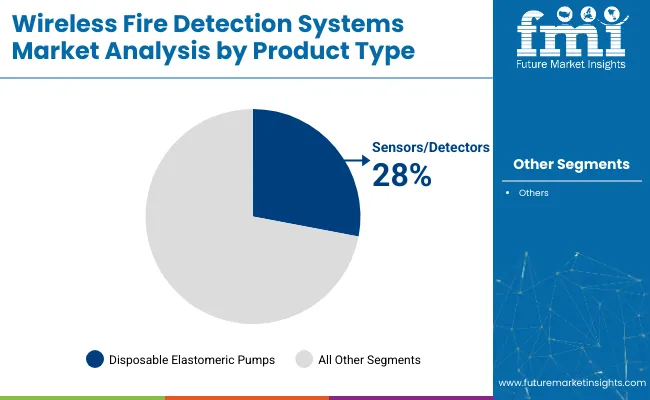
Retrofit installations are estimated to hold a major share, accounting for nearly 56% of the installation segment in 2025. Growth is being propelled by the need to modernize aging infrastructure, especially in North America and Europe, where older buildings require compliant, scalable, and minimally invasive fire detection solutions.
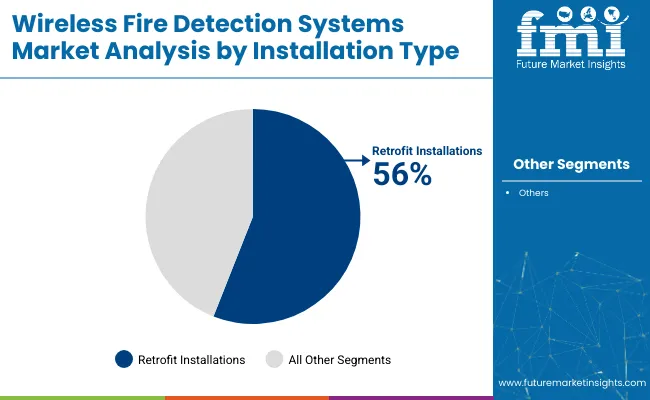
Wireless systems are projected to maintain the largest market share, accounting for approximately 65% of the global wireless fire detection systems market in 2025.
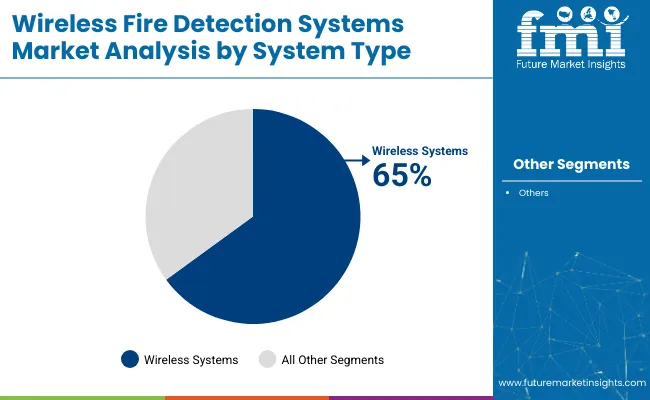
The indoor segment is anticipated to maintain its dominance with a 70% share in 2025, as most fire detection installations are mandated within residential, commercial, and industrial buildings to ensure occupant safety.
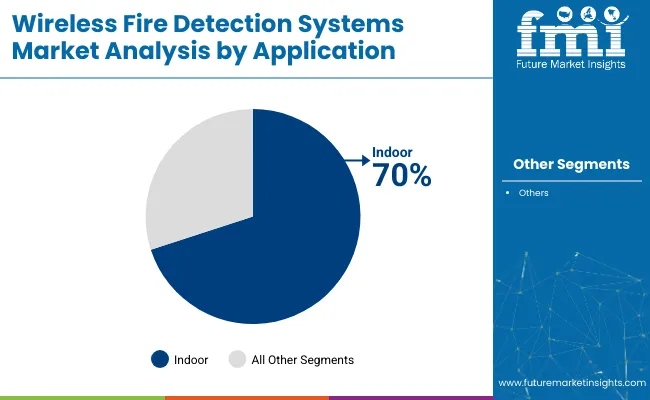
The commercial sector is estimated to contribute around 34% of the market share in 2025. Growth is being driven by stringent fire safety regulations in offices, malls, and hospitality buildings, alongside the rising trend of smart commercial facilities integrating AI and IoT-enabled fire detection solutions.
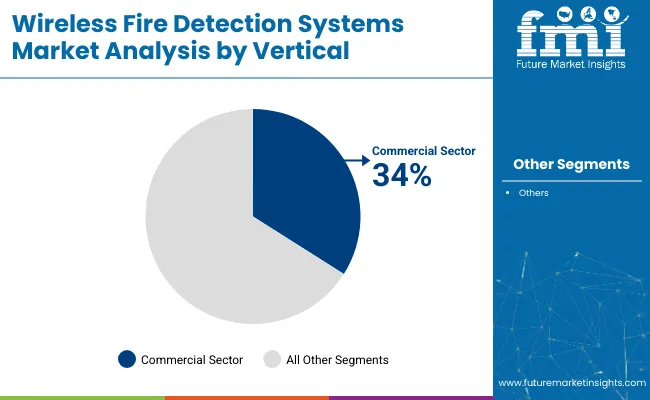
Recent Wireless Fire Detection System Market Trends
Challenges the Wireless Detection System Market Facing
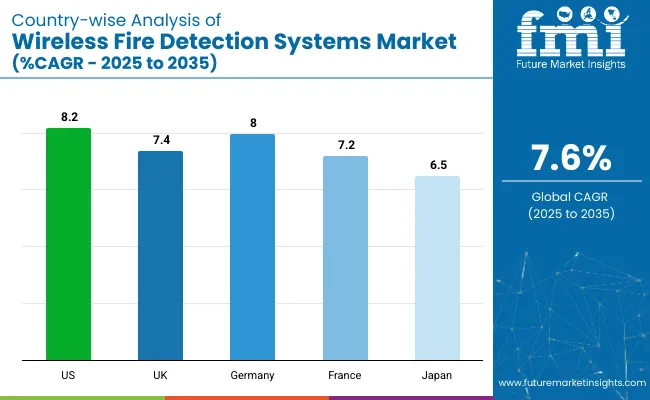
The United States is projected to experience the fastest growth in the wireless fire detection systems market, with a CAGR of 8.2% from 2025 to 2035. This growth is driven by stringent fire safety regulations, AI and IoT integration, and increasing retrofitting projects. Germany follows closely with an 8.0% CAGR, propelled by strong regulations and digitalization in the construction sector.
The United Kingdom is expected to grow at a 7.4% CAGR, fueled by post-Grenfell reforms and smart city developments. France and Japan have slightly lower growth rates of 7.2% and 6.5%, respectively, due to varying adoption speeds and regulatory environments.
The report covers in-depth analysis of 40+ countries; five top-performing OECD countries are highlighted below.
The USA wireless fire detection systems revenue is projected to register a CAGR of 8.2% from 2025 to 2035. Growth is being driven by stringent fire safety regulations enforced at the federal and state levels alongside the rapid adoption of AI-integrated and IoT-enabled fire detection solutions.
The revenue from the wireless fire detection systems market in the UK is forecast to expand at a CAGR of during 2025 to 2035.
The wireless fire detection systems market in Germanyis expected to grow at a CAGR of 8.0% between 2025 and 2035. The market expansion is driven by robust fire safety regulations, rapid digitalization in the construction sector, and the widespread integration of hybrid fire detection systems in public and commercial buildings to enhance safety compliance and operational efficiency.
The sales of wireless fire detection systems in France are projected to grow at a CAGR of 7.2% from 2025 to 2035. Market growth is driven by the enforcement of strong fire safety standards, mandatory CE certification, and increasing demand for energy-efficient, IoT-integrated fire safety solutions in smart building and renovation projects aligned with sustainability targets.
The wireless fire detection systems demandin Japan is anticipated to expand at a CAGR of 6.5% through 2035. Despite being a mature market, growth is steady due to urbanization, the need for compact designs in high-density cities, and the gradual adoption of IoT and AI technologies for enhanced predictive monitoring in commercial and residential sectors.
The market is moderately consolidated, with major players such as Honeywell International Inc., Siemens AG, Johnson Controls, Hochiki Corporation, and Schneider Electric accounting for substantial market shares.
Competition is driven by pricing strategies, continuous innovation in AI and IoT integration, strategic mergers & acquisitions, and expansion into emerging smart city infrastructures. Companies are strengthening their portfolios with advanced wireless solutions featuring predictive maintenance, AI-driven analytics, and seamless integration with building management systems.
Recent Wireless Fire Detection Systems Industry News
In December 2024, Siemens acquired Danfoss Fire Safety to boost its sustainable fire suppression portfolio.
| Report Attributes | Details |
|---|---|
| Current Total Market Size (2025) | USD 1.6 billion |
| Projected Market Size (2035) | USD 3.1 billion |
| CAGR (2025 to 2035) | 7.6% |
| Base Year for Estimation | 2024 |
| Historical Period | 2020 to 2024 |
| Projections Period | 2025 to 2035 |
| Market Analysis Parameters | Revenue in USD billions/Volume in units |
| By Product Type | Sensors, Detectors, Call Points, Fire Alarm Panels, Modules |
| By Installation Type | New Installation, Retrofit Installation |
| By System Type | Wireless, Hybrid |
| By Application | Indoor, Outdoor |
| By Vertical | Residential, Commercial, Government, Industrial |
| Regions Covered | North America, Latin America, Europe, East Asia, South Asia & Pacific, MEA |
| Countries Covered | United States, Canada, Germany, United Kingdom, France, China, Japan, South Korea, India, Australia |
| Key Players | Honeywell International Inc., Siemens AG, Johnson Controls, Hochiki Corporation, Schneider Electric, Bosch Security Systems, UTC, Nest Labs, Kidde, Apollo Fire Detectors Ltd., Testo AG, Vanderbilt Industries, EMS Safety Services |
| Additional Attributes | Dollar sales by value, market share analysis by region, and country-wise analysis |
Sensors/Detectors, Call Points, Fire Alarm Panels and Modules, and Input/ Output Modules
New Installation and Retrofit Installation
Wireless Systems and Hybrid Systems
Indoor and Outdoor
Residential, Commercial, Government, and Manufacturing
North America, Latin America, Europe, Asia Pacific, and Middle East and Africa
The market is valued at USD 1.6 billion in 2025.
The market is forecasted to reach USD 3.1 billion by 2035, reflecting a CAGR of 7.6%.
Wireless systems are projected to grow at the fastest, with a market share of 65% in 2025.
Indoor applications are expected to lead the market due to their wide use in commercial and residential buildings.
The USA is anticipated to post the highest CAGR of 8.2% from 2025 to 2035.






Our Research Products

The "Full Research Suite" delivers actionable market intel, deep dives on markets or technologies, so clients act faster, cut risk, and unlock growth.

The Leaderboard benchmarks and ranks top vendors, classifying them as Established Leaders, Leading Challengers, or Disruptors & Challengers.

Locates where complements amplify value and substitutes erode it, forecasting net impact by horizon

We deliver granular, decision-grade intel: market sizing, 5-year forecasts, pricing, adoption, usage, revenue, and operational KPIs—plus competitor tracking, regulation, and value chains—across 60 countries broadly.

Spot the shifts before they hit your P&L. We track inflection points, adoption curves, pricing moves, and ecosystem plays to show where demand is heading, why it is changing, and what to do next across high-growth markets and disruptive tech

Real-time reads of user behavior. We track shifting priorities, perceptions of today’s and next-gen services, and provider experience, then pace how fast tech moves from trial to adoption, blending buyer, consumer, and channel inputs with social signals (#WhySwitch, #UX).

Partner with our analyst team to build a custom report designed around your business priorities. From analysing market trends to assessing competitors or crafting bespoke datasets, we tailor insights to your needs.
Supplier Intelligence
Discovery & Profiling
Capacity & Footprint
Performance & Risk
Compliance & Governance
Commercial Readiness
Who Supplies Whom
Scorecards & Shortlists
Playbooks & Docs
Category Intelligence
Definition & Scope
Demand & Use Cases
Cost Drivers
Market Structure
Supply Chain Map
Trade & Policy
Operating Norms
Deliverables
Buyer Intelligence
Account Basics
Spend & Scope
Procurement Model
Vendor Requirements
Terms & Policies
Entry Strategy
Pain Points & Triggers
Outputs
Pricing Analysis
Benchmarks
Trends
Should-Cost
Indexation
Landed Cost
Commercial Terms
Deliverables
Brand Analysis
Positioning & Value Prop
Share & Presence
Customer Evidence
Go-to-Market
Digital & Reputation
Compliance & Trust
KPIs & Gaps
Outputs
Full Research Suite comprises of:
Market outlook & trends analysis
Interviews & case studies
Strategic recommendations
Vendor profiles & capabilities analysis
5-year forecasts
8 regions and 60+ country-level data splits
Market segment data splits
12 months of continuous data updates
DELIVERED AS:
PDF EXCEL ONLINE
Wireless EEG Monitoring System Market Size and Share Forecast Outlook 2025 to 2035
Wireless Refrigerant Charging Scale Market Size and Share Forecast Outlook 2025 to 2035
Wireless Hydrometer Market Size and Share Forecast Outlook 2025 to 2035
Wireless HDMI Transmitter and Receiver Market Size and Share Forecast Outlook 2025 to 2035
Wireless Access Point Market Size and Share Forecast Outlook 2025 to 2035
Wireless Video - 2.4/5GHz Market Size and Share Forecast Outlook 2025 to 2035
Wireless Polysomnography Market Size and Share Forecast Outlook 2025 to 2035
Wireless Audio Devices Market Size and Share Forecast Outlook 2025 to 2035
Wireless Communication Technologies In Healthcare Market Size and Share Forecast Outlook 2025 to 2035
Wireless Mesh Network Market Size and Share Forecast Outlook 2025 to 2035
Wireless Sensor Tags Market Size and Share Forecast Outlook 2025 to 2035
Wireless Sensor Network Market Size and Share Forecast Outlook 2025 to 2035
Wireless Power Transmission Market Size and Share Forecast Outlook 2025 to 2035
Wireless Home Security Camera Market Size and Share Forecast Outlook 2025 to 2035
Wireless Testing Market Size and Share Forecast Outlook 2025 to 2035
Wireless Power Bank Market Size and Share Forecast Outlook 2025 to 2035
Wireless Battery Monitoring System Market Size and Share Forecast Outlook 2025 to 2035
Wireless Printer Market Size and Share Forecast Outlook 2025 to 2035
Wireless Headphones Market Size and Share Forecast Outlook 2025 to 2035
Wireless Sensors Market Size and Share Forecast Outlook 2025 to 2035

Thank you!
You will receive an email from our Business Development Manager. Please be sure to check your SPAM/JUNK folder too.
Chat With
MaRIA